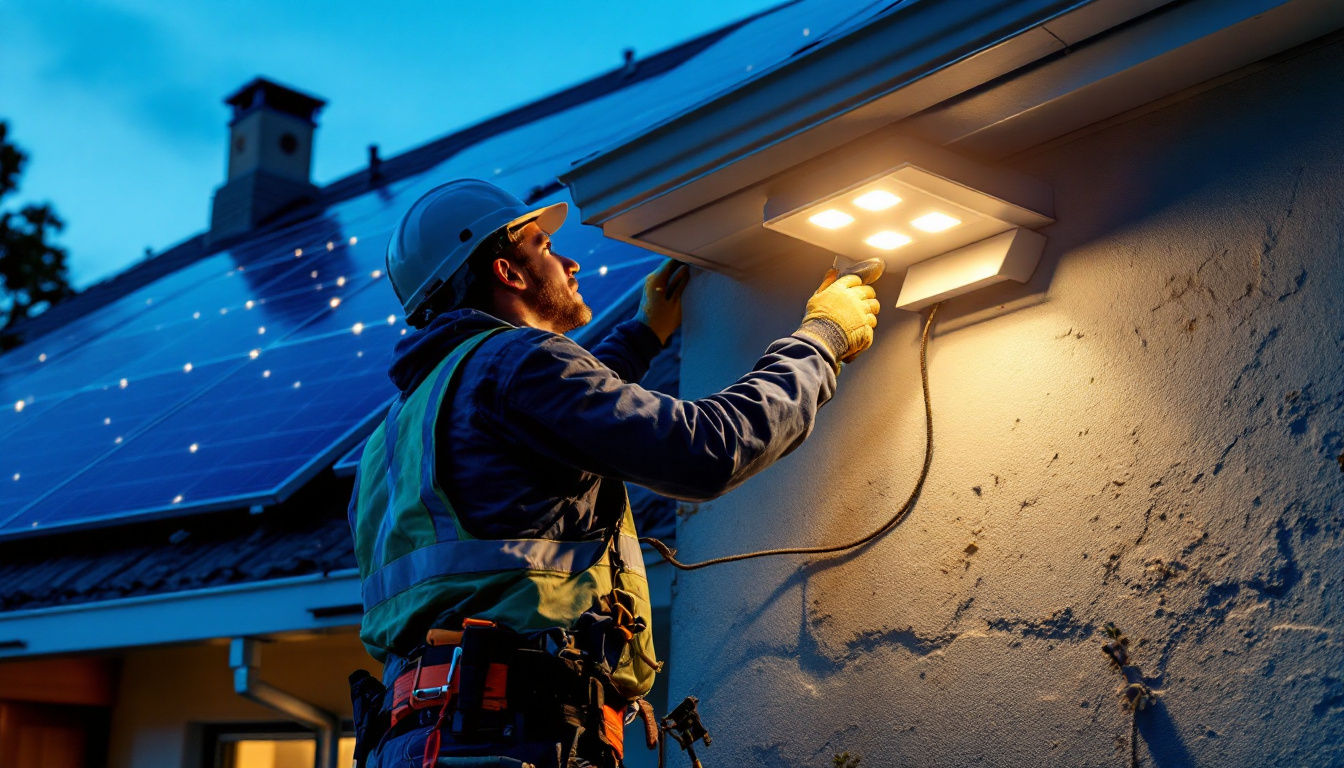
In the ever-evolving landscape of lighting solutions, solar sign lights have emerged as a viable option for contractors seeking sustainable and cost-effective lighting solutions. However, despite their growing popularity, many lighting contractors often overlook critical aspects when integrating these systems into their projects. This article delves into the nuances of solar sign lights, highlighting common oversights and offering insights to enhance project outcomes.
Solar sign lights are designed to illuminate signs using energy harvested from sunlight. They are equipped with solar panels, batteries, and LED lights, making them a self-sufficient lighting option. The appeal of solar sign lights lies not only in their energy efficiency but also in their minimal environmental impact. By utilizing solar energy, these lights contribute to a greener planet and promote sustainability, which is increasingly important in today’s eco-conscious society.
To appreciate the benefits of solar sign lights, it is essential to understand their main components. The solar panel captures sunlight and converts it into electricity, which is stored in rechargeable batteries. During the night, the stored energy powers the LED lights, ensuring that signs remain visible even in low-light conditions. The efficiency of modern solar panels allows them to generate power even on cloudy days, making them a reliable choice for various climates.
Moreover, many solar sign lights come with built-in sensors that automatically turn the lights on at dusk and off at dawn, further optimizing energy use. This automation enhances the convenience of installation, as contractors do not need to integrate complex wiring systems. Some advanced models even feature adjustable brightness settings, allowing users to customize the light output based on their specific needs, whether it’s for a bustling business or a quiet residential area.
One of the most significant advantages of solar sign lights is their sustainability. By relying on renewable energy, they reduce dependence on fossil fuels and lower carbon footprints. Additionally, they offer substantial cost savings over time, as they eliminate electricity costs associated with traditional lighting methods. This makes them not only an environmentally friendly option but also a financially savvy choice for businesses and homeowners alike.
Furthermore, solar sign lights are often easier to install than conventional lighting systems, especially in remote or hard-to-reach locations. The absence of wiring reduces installation time and labor costs, making them an attractive option for contractors looking to streamline their projects. In addition, the durability of solar sign lights, often designed to withstand harsh weather conditions, ensures that they require minimal maintenance over their lifespan. This reliability, combined with the ease of installation, makes solar sign lights a smart investment for anyone looking to enhance visibility and safety without the hassle of traditional lighting solutions.
Despite the clear advantages of solar sign lights, many contractors fail to consider several critical factors that can impact the performance and longevity of these systems. Addressing these oversights can lead to more successful installations and satisfied clients.
One of the most significant factors affecting the efficiency of solar sign lights is their exposure to sunlight. Contractors often overlook the importance of conducting a thorough site assessment to determine the optimal placement of solar panels. Factors such as surrounding trees, buildings, and other obstructions can significantly impact the amount of sunlight the panels receive.
To maximize performance, it is essential to identify locations that receive direct sunlight for the majority of the day. This may require adjustments to the sign’s positioning or even the selection of different solar models that can perform better in partial shade. Furthermore, understanding seasonal changes in sunlight exposure is vital; the angle of the sun shifts throughout the year, which can affect how much light the panels receive. Contractors should consider using tools like solar pathfinders or shading analysis software to accurately assess the site and make informed decisions about panel placement.
Another common oversight involves the selection of battery capacity and type. Many contractors assume that all solar lights come with adequate battery storage, but this is not always the case. The battery’s capacity directly influences how long the lights will operate during the night, especially in areas with shorter daylight hours.
Contractors should consider the specific energy requirements of the lighting system and choose batteries that can support those needs. Lithium-ion batteries, for instance, offer longer life spans and better performance in varying temperatures compared to traditional lead-acid batteries. Additionally, understanding the charging cycles and discharge rates of different battery types can help contractors select the most efficient option for their clients. It’s also beneficial to inform clients about the potential for battery upgrades in the future, allowing for enhanced performance as technology continues to evolve.
Maintenance is often an afterthought in the planning stages of a project. However, solar sign lights require periodic maintenance to ensure optimal performance. Dust, debris, and snow can accumulate on solar panels, reducing their efficiency. Contractors should educate clients about the importance of regular cleaning and inspections to maintain the lights’ functionality.
Additionally, it is crucial to consider the lifespan of the components used in solar sign lights. LEDs have a long life, but other components, such as batteries, may need replacement after a few years. Contractors should provide clients with a maintenance schedule and information on how to care for their solar lighting systems. They might also suggest the installation of monitoring systems that can alert clients to performance issues or component failures, thus enabling proactive maintenance. By fostering a culture of regular upkeep, contractors can help ensure that solar sign lights continue to operate efficiently and effectively for years to come.
Selecting the right solar sign light for a project involves more than just considering aesthetics. It requires a comprehensive understanding of the specific needs of the sign and the environment in which it will be installed.
The light output of solar sign lights is measured in lumens, and it is essential to choose a model that provides adequate illumination for the intended purpose. Contractors should assess the visibility requirements of the sign and select lights that meet or exceed those needs.
For example, a highway sign may require a higher lumen output than a sign in a residential area. Understanding these requirements ensures that the sign remains visible and effective, regardless of the surrounding conditions.
Solar sign lights are exposed to various weather conditions, making durability a key consideration. Contractors should look for models that are built to withstand harsh environments, including extreme temperatures, rain, and snow. Materials such as high-impact plastics and corrosion-resistant metals can enhance the longevity of the lights.
Additionally, the ingress protection (IP) rating of the lights can provide insight into their resistance to dust and moisture. A higher IP rating indicates better protection, which is crucial for outdoor installations.
Proper installation is vital for the performance of solar sign lights. Following best practices can help ensure that the lights function optimally and provide the desired illumination.
The angle at which solar panels are installed can significantly affect their efficiency. Ideally, panels should be positioned to face south in the northern hemisphere and north in the southern hemisphere to capture the maximum amount of sunlight. Contractors should also consider the tilt angle, which can vary based on geographic location.
By ensuring that solar panels are correctly angled, contractors can enhance the energy collection capabilities of the lights, leading to better performance during the night.
Secure mounting is essential to prevent solar sign lights from being damaged by wind or other environmental factors. Contractors should use appropriate mounting hardware and techniques to ensure that the lights remain stable and secure over time.
Additionally, it is wise to check local regulations regarding mounting heights and visibility requirements to ensure compliance. This can prevent potential issues during inspections and enhance the overall effectiveness of the installation.
Educating clients about the benefits and maintenance of solar sign lights can significantly enhance their satisfaction and the longevity of the installation. Providing comprehensive information ensures that clients understand how to maximize the performance of their solar lighting systems.
Contractors should offer clear and concise instructions on how to operate and maintain solar sign lights. This includes information on cleaning the solar panels, checking battery levels, and understanding the automatic operation of the lights.
Additionally, providing contact information for support can help clients feel more comfortable reaching out with questions or concerns. This proactive approach can lead to stronger client relationships and repeat business.
Many clients are increasingly concerned about sustainability and environmental impact. Highlighting the eco-friendly aspects of solar sign lights can resonate with these clients, making them more likely to choose solar options over traditional lighting systems.
By emphasizing the reduction in carbon footprint and the use of renewable energy, contractors can appeal to environmentally conscious clients and differentiate themselves in a competitive market.
Solar sign lights represent a significant opportunity for lighting contractors to provide sustainable and cost-effective solutions. However, overlooking critical factors such as site assessment, battery selection, and maintenance can hinder the performance and longevity of these systems.
By understanding the components of solar sign lights, addressing common oversights, and following best practices for installation and client education, contractors can enhance the effectiveness of their projects. Embracing solar technology not only benefits the environment but also positions contractors as forward-thinking professionals in the lighting industry.
As the demand for sustainable lighting solutions continues to grow, lighting contractors who prioritize solar sign lights will be well-positioned to meet the needs of their clients while contributing to a greener future.
Ready to take your lighting projects to the next level with sustainable and cost-effective solar sign lights? At LumenWholesale, we provide lighting contractors like you with the highest quality, spec-grade lighting products at unbeatable wholesale prices. Say goodbye to local distributor markups and hello to our extensive selection that meets rigorous industry standards. With free shipping on bulk orders, you can trust that you’re getting premium lighting solutions at the best value — no hidden fees, no compromises. Enhance your lighting projects and support a greener future with LumenWholesale. Wholesale Lighting at the Best Value.

Discover essential tips and expert insights for lighting contractors looking to master T8 LED lighting installations.

Discover the innovative strategies lighting contractors are using to integrate LED and solar technologies.

Discover the importance of Hanging Shop Lights Work 48 LED 5000 Kelvin for lighting contractors.

Discover how UV light boxes can transform your lighting business with increased efficiency and profitability.